ai-ley
4 posts
21 years and counting of media memories!
Don't wanna be here? Send us removal request.
Text
RTA 950 Final Blog Post - Written at an altitude of roughly 35,000ft!
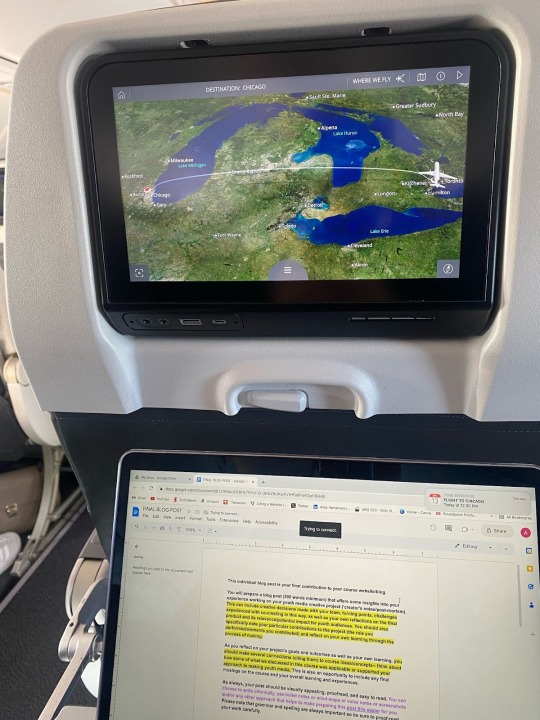
I wrote most of this blog post during my flight home, so of course I had to include a plane pic!
From the first look at the syllabus, I knew that my YMCP would focus on queerness in some capacity. As someone whose journey of coming to terms with her sexuality was very much intertwined with media consumption (see below…), I deeply understand the power of representation and the connection between storytelling and identity.
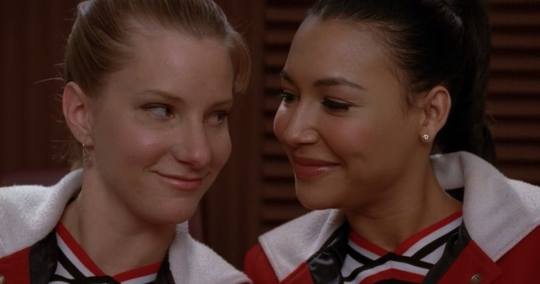
Brittany and Santana from Glee, via Bustle
“I love Santana and Brittany a normal amount, I swear! I don’t have a weird attachment to their relationship! I’m straight!” - 13-year old me, probably
I was also very lucky to work with Karlie and Emma for this final project; while we had similar goals and experiences, our different creative approaches made this a challenging but enjoyable process. A personal aside: having the opportunity to work with two other lesbians (and friends, of course!) was very rewarding. Being a lesbian can be isolating. Exploring our shared struggles and working together to fight the loneliness that our tween selves experienced was both cathartic and fun. We laughed a lot during this process!
Because Karlie, Emma and I understand how formative the tween years are for queer youth, centering tweens and media representation felt like the best way to accomplish our goals of providing an “older sister” perspective and exploring the nuances of queer kids’ content. Though we had a solid goal, determining the exact method of execution was challenging. What started as a Zine became a Tiktok account, a blog, and then finally, a video essay and Tiktok page. Our biggest initial flaw was a lack of consideration for our audience. While we knew what topics our audience needed, there were times when we let our personal preferences or past experiences get in the way of finding a suitable platform for tweens today. After much consideration, we landed on Tiktok as the best platform. Social media is proven to “...open up opportunities for information seeking, communication, collaboration, and media literacy among learners in different spaces” (Herr Stephenson 2021, p. 472). Though not designed as an explicitly educational site, informal engagement with Tiktok offers valuable learning opportunities in a tween-accessible way.

Sailor Uranus and Sailor Neptune via Tumblr.
As Sailor Moon fans and lovers of all things queer and nostalgic, the three of us knew that the relationship between these two (...Cousins?) would make for an engaging, relevant topic. It’s perfect that the “retro” Sailor Moon is making its Tiktok comeback!
For our final product, I mostly focused on the video essay. After a group brainstorming session, I did some research, co-wrote the script with Karlie, and recorded/touched up the audio so it was completely ready for visuals. I also helped brainstorm and write a few of the Tiktoks and created the video discussion questions. At first, I defaulted to my usual “academic podcast” style of scripting and presenting, which doesn’t make for the most compelling product for 11-15 year-olds; once again, I was distracted by my own methods and ended up neglecting the youth perspective. Upon reflection, I feel like I should have a swear jar-esque system where I put a looney into a jar every time I don’t consider the youth perspective.

An artistic rendering of my “Neglecting Youth Perspectives” Jar. Made with Canva!
It was harder than I thought to break out of my usual mold, but the class’s feedback during our group presentation was constructive and encouraged us to pivot our project one last time. Since it was a bit too late to completely change the video, we decided to make the video essay a specifically academic piece designed for schools. Going back to both Matthew Johnson’s presentation and Tatyana’s research, this course has strongly emphasized how important it is to meet kids where they are. Effective media education respects that “Children and youth know more about these new media environments than most parents and teachers. In fact, we do not need to protect them so much as engage them in critical dialogues that help them to articulate more fully their intuitive understandings of these experiences” (Jenkins 2009, p. 12). Working to understand (Research! Research! Research!) and utilize the platforms that youth are engaging with is key to designing effective curriculum.
As such, we also decided to add a few, more tween-friendly Tiktoks as an aside to our educational video, to better appeal to the target audience and provide more accessible methods of engaging with our project. We also worked to make the video more visually/tonally compelling for younger audiences so it wouldn’t be a total snooze-fest if they were watching it in class. I hope that this type of project could help queer youth feel safer exploring their own identities and make critical conversations about queerness, representation, and media literacy more accessible and prevalent within middle and high school settings. I’m very interested in media education, so it was great to be able to further explore youth media through this type of mini-curriculum development. I’m very happy with the final form that this project took, and I can confidently say that my passion for youth media and education has only grown with each class.
Overall, I enjoyed our weekly discussions and hearing my peers' diverse perspectives. It was also great to see everyone’s approaches to the YMCP, many of which offered really lovely and valuable ways of connecting to youth. How lucky I am to be exploring a field filled with so much hope, potential, and joy-- and how lucky I am that there is so much more to learn. 🌸
Thank you for a great semester!
Citations ->

0 notes
Text
RTA 950 Topic Summary/Critical Reflection - Journal #2
In Week 8, we discussed the diverse ways that children engage with new media, including how they consume, create, and learn about media technologies and storytelling. As we’ve explored in class, kids in Canada today are engaging with new media in astounding, unprecedented ways. Their technological savvy and innate understanding of media cultures is a fascinating and rapidly-evolving topic, as is the way they learn through and about new media. Of course, strong critical analysis is required to best understand youth media engagement, which is explored in Week 8’s reading →
In “New Media and Informal Learning” from The Routledge International Handbook of Children, Adolescents, and Media, Rebecca Herr Stephenson describes the relationship between new media and learning through three main frameworks: New Media Literacies, Genres of Participation, and Connected Learning. These frameworks have informed research studies in many disciplines and “...identify technical proficiencies and social practices conducive to successful learning with and through new media” (2021, pp. 467-468). There is a strong emphasis on classifying different types of participation, or literacies, and how they shape young people’s learning and identity-building in the digital age (469). There is also an emphasis on youth organizations and programs that aim to teach these participation skills and help youth navigate unequal educational landscapes (470). As we discussed in class, frameworks are an important method of forming a common consensus about how we talk about children’s media use. They are also critical to understanding how we need to combat barriers to access to ensure that all children develop an understanding of the technologies that will shape their lives.
While the general Canadian curriculum includes mandatory media education, much of this learning happens outside of traditional classroom contexts. In fact, depending on resources and instructors, it’s arguable that many kids may learn more about new media from their daily Tiktok scroll than a media lesson in school. For this blog post, I want to take a brief look at how “...informal engagement with new media – even when that media is not designed with explicit educational goals in mind – can lead to substantial and valuable learning” (468).
A few weeks ago, I saw a viral tweet by someone whose younger cousin was protesting for Palestine on Roblox. Attached was a video from the server itself, where dozens of blocky avatars were adorned with flags and “Free Palestine” text boxes. At first, I was mostly amused. Roblox has always seemed like the Wild West of gaming to me, and the idea of such serious social discourse on the platform felt a bit silly.

@funnecfox via Twitter
As I scrolled through a series of similar tweets, however, I started to realize just how incredible this situation really was. Virtual activism has been a hot topic for some time now; I distinctly remember when victims of the Stoneman Douglas school shooting in Florida took to social media to launch a campaign against gun violence in the US, rocketing youth/online activism into the national dialogue. However, while a lot of online activism has happened on social media sites such as Instagram and Twitter, the Roblox protests may be one of the first times we’re seeing it unfold on a platform made entirely for kids.

Stoneman Douglas shooting survivors and "March For Our Lives" organizers via Time
With an average user age of twelve years-old, Roblox players’ engagement with social issues is an unprecedented look into the educational potential of youth-centered new media. Herr Stephenson writes that “Games are opportunities to connect socially, to explore and experiment, develop expertise, and learn to participate with and through media” (471). Activism on Roblox allows kids to learn about social issues that they otherwise may not have exposure to. It also teaches them about the vast potential of new media itself, such as the power of online activism and collective action through the Internet. Finally, this sort of engagement is a valuable form of identity-building for youth; kids’ exploration of social issues within platforms and communities they’re comfortable in allows them to more freely explore their identities and where they situate themselves in the world. It also helps them develop their own values and political stances, independent of their parents. While I explored a more structured, purposeful educational Roblox space for Week 8’s Padlet activity, it’s fascinating to see the different types of learning that comes from such a vibrant platform. I’m genuinely amazed at Roblox’s ability for all kinds of learning, both formal and informal, and how formative it likely is to kids growing up today.
Of course, there are dangers to youth engagement with new media. While new media provide numerous opportunities for learning and growth, there are equally as many opportunities to learn hate and bigotry, as indicated by the rise of the Alt-Right pipeline.

via The Washington Post
However, as I explored in my previous blog post, succumbing to “moral panics” about kids’ exposure to media is ineffective and only limits children’s autonomy (Berriman 2022, p. 75). Henry Jenkins puts it best in Week 9’s reading, arguing that “Children and youth do know more about these new media environments than most parents and teachers. In fact, we do not need to protect them so much as engage them in critical dialogues that help them to articulate more fully their intuitive understandings of these experiences” (2009, p. 12). Nobody knows more about youth media cultures than youth themselves. Rather than panic about this evolving landscape, we need to focus on listening to youth perspectives and designing media education that respects their knowledge, agency, and the world they’re growing up in.
Citations ->

0 notes
Text
RTA 950 Topic Summary/Critical Reflection - Journal #1
In Week 3, we discussed the importance of understanding and centering youth audiences in the contemporary children’s media landscape. While this was the specific topic of the week, focusing on youth perspectives has been a consistent theme in each class, which speaks to its relevance within the course as a whole. This topic is also very important considering the extent to which youth engage with media every single day, which we discussed as a group after analyzing the Media Technology Monitor documents. Given various differences in media consumption based on gender, ethnicity, class, and more, it’s important to consider how sociocultural contexts and youth perspectives might influence how youth consume and create media. However, this hasn’t always been the consensus among media researchers and producers, who have historically neglected and underestimated youth POVs. This issue was explored in Week 3’s reading →
In “Childhood Studies Approaches to the Study of Children in Media” from The Routledge International Handbook of Children, Adolescents, and Media, Liam Berriman explores children’s media research through the lens of childhood studies. Berriman describes the evolving ways scholars perceive children’s relationships with media based on their understandings of childhood, agency, and the public discourses surrounding children’s media consumption in general (2022, p. 73). He gives special focus to children’s agency, detailing how newer fields of childhood studies aim to “recognise children as social beings (rather than social becomings), who are active and agentic in their engagement with society and culture” (2022, p. 74). This led to a more child-centered approach to research, which placed emphasis on youth perspectives (2022, p. 78).
A key part of this chapter is the theory of childhood as a social construction, which emerged during a formative time in the field and argues that “childhood” is a social and cultural concept rather than an inherent biological phase. Berriman argues that the concept of childhood innocence, for example, is a social construct that limits children’s autonomy and is the root of many widespread moral panics about children (2022, p. 75). This section of the reading particularly resonated with me. These days, intolerant and hateful rhetoric is constantly disguised as a purported “concern” for the wellbeing of children. Especially in the US, I’’m constantly seeing news stories about book bannings and other forms of public outcry centered around kids’ exposure to certain media, which are textbook examples of the moral panics that Berriman describes.

Most banned books in the first half of the 2022-2023 school year via PEN America
In these cases, the social constructions of childhood and innocence have been weaponized by adults who claim that children are “too young” to engage with certain topics, which automatically implies that these topics- often queerness, critical race theory, or sex ed- are inherently dirty and not appropriate to be taught or engaged with. As Buckingham and Willett note in Week 5’s reading, these discourses nearly always come from adults on behalf of their poor, vulnerable children, though there is usually little to no input from those children themselves (2021, p. 50). Even within socio-political movements about their own wellbeing, youth perspectives are not taken into account. I can’t help but wonder what the results might look like if you asked the kids, rather than the adults, about their opinions on the so-called “harmful” media that they need to be protected from. Based on our class discussions about appreciation for diverse types of media, I theorize that youth are far more tolerant and reflective towards media than their parents might expect. In this way, considering youth perspectives could help fight back against new waves of bigotry and censorship.
I was also reminded of the importance of centering youth perspectives in last week’s class (Week 6). During our class discussion, it was argued that the representation of more “difficult” subjects, like chronic illness or death, isn’t entirely necessary because it could sadden kids and take away from the entertainment value of kids’ programs. I strongly disagreed with this for various reasons, but takes like these are a reminder of just how important it is to consider what youth audiences are feeling.
From the “adult-centered” POV that considers children as passive victims of media messages, it might make sense; why subject kids to sensitive subjects? Why not make everything sunshine and rainbows, so as not to harm them? However, the reality of the situation is different if we consider how media and storytelling help youth develop as competent social beings who are “active in the construction and determination of their own lives..” (Berriman 2022, p. 76). Whether it be a sense of discovery about learning something new, an increased level of cultural awareness or understanding of those different from you, or the feeling of finally belonging when seeing yourself represented on-screen, representing different identities and experiences is vital to helping children learn about their place in the world, even if the topics are more complex.
In Week 3’s Meaningful Media Memories presentation, for example, Karlie showed a clip from Adventure Time that alluded to the struggles of family members of those with dementia. While dementia is an immensely painful experience, Karlie discussed how the show’s ability to tackle real-world themes within its fantasy setting was especially meaningful to her as a child. Without exposure to more “serious” issues through children’s television like Adventure Time, Karlie may have missed out on formative types of social and emotional learning. The show has been widely recognised for its impactful storylines, and its popularity speaks to what youth truly want and need from the media they consume.
I’m also reminded of the show 16 Hudson, an animated children’s program about various multicultural families in an apartment complex. In Children’s Programming last year, we watched an episode of the show where the protagonists get to know a refugee family. While the episode had many moments of warmth and humour, it also acknowledged the pain that refugees go through and the struggles of leaving your home country. Rather than censor this multifaceted topic, 16 Hudson took a youth-centered approach by framing the topic in a simplified way that made sense to its young audience while still providing a valuable, emotional learning opportunity. I think there is great value in how 16 Hudson respects and understands its audience enough to know how to approach all types of topics, even complex sociopolitical issues.
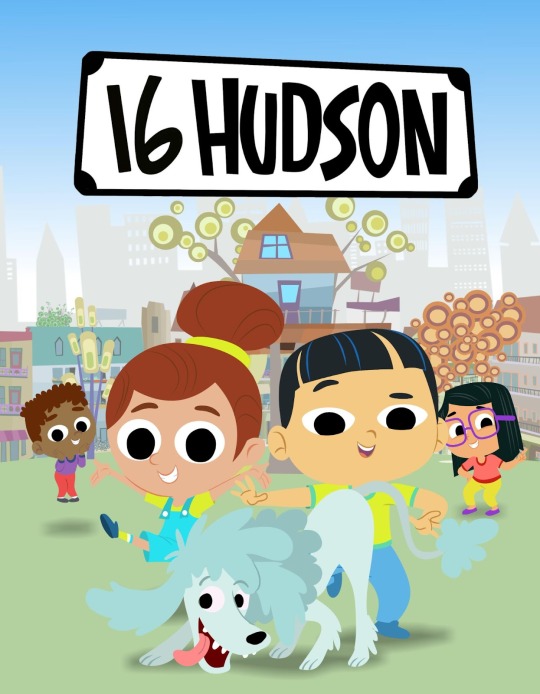
16 Hudson via IMDb
Citations ->
While understanding and centering youth audiences was the specific theme of Week 3, youth audiences are rightfully at the forefront of many discussions we have in this class. As a future children’s media producer, I hope to tell stories that respect, understand, and centre youth audiences to give them the most engaging and educational storytelling experiences.

0 notes
Text
RTA 950 - Meaningful Media Memories 1
What I watched with everyone...
During my tween years, Pretty Little Liars (PLL) must have been the pinnacle of teen TV. It’s no surprise that it was all the rage among my age group; the mystery was thrilling, the romances were juicy, and it was just “adult” enough that we all felt cool for watching it. Netflix made it easily accessible and allowed for endless replayability of our favourite scenes and episodes, and my friends and I used to sit in the lunchroom and discuss our outlandish theories or comment on the characters’ poor decision-making (“If that happened to me, I would’ve just called the police!”). While PLL was my poison, The Fosters and The Vampire Diaries are other examples of shows that girls my age were similarly engaging with.
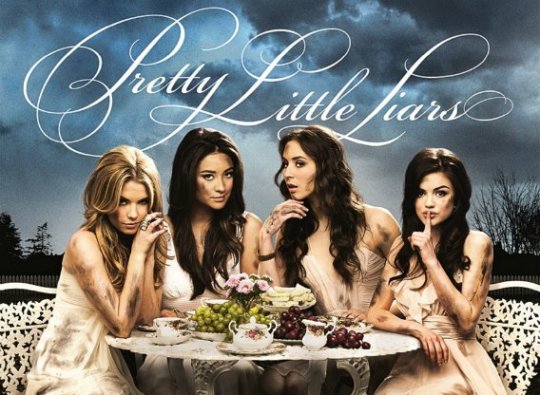
Pretty Little Liars via Netflix
Looking back on those days serves as a powerful reminder of the screen’s “...omnipresence in every aspect of young people’s lives…” (Lemish, 2022, p. 3). Go to school and learn with a Chromebook; talk about television at lunch; go home and study with the computer; entertain yourself with more television or your phone. Putting it like this makes it seem a tad dystopian, but I agree with Lemish’s analysis that we need to let go of alarmist concerns over screen-time and its negative effects (p. 1).
Was PLL quality content that made me a more upstanding citizen? Probably not. Would my time have been better spent disengaging with screens and touching grass? Possibly. However, a sense of community is a powerful thing, especially at twelve or thirteen. While adults may have seen us as shallow, TV-obsessed teen girls (emphasis on girls), our conversations explored real issues around storytelling, media literacy, and representation, even if we didn’t quite realize it yet. For us, screen-time translated into a greater understanding of relevant issues and a healthy, fun social outlet.
Though screens permeated most levels of my life, it was television like PLL and its impact on my social life that I remember most. Even as an adult, I consider “watching” something with others to be a genuinely meaningful activity.
What was equally as formative, however, was what I watched when no one was looking. →
And what I watched alone:
Although globalization and business interests have created a constantly evolving kids’ media industry, “Children’s television content is still characterized by programming designed to meet the needs of children” (Steemers, 2021, p. 107). The big question, then, is obvious: What do children need? As a tween, what I needed was something that most media products targeted towards my age group couldn’t give me, so I went and found it myself.
When I was around thirteen years-old, I religiously watched the lifestyle content of a lesbian couple named Shannon and Cammie, one of the few pairs dominating the sapphic vlogger scene at the time. Their videos consisted of all the regular “couples’ YouTube channel” content, with various challenges, vlogs, and Q&As to feed their viewers’ curiosity (and probably jealousy!) about their happy, happy life. Shannon and Cammie have long since broken up, but their content provided me with glimpses of a daily normalcy that I hadn’t thought was achievable for queer people.
youtube
Shannon and Cammie’s viral breakup video via YouTube
Vloggers were all anybody talked about back then, but I watched Shannon and Cammie with the doors locked and the blinds shut, paranoid that someone would see what I was watching and catch on to my unseemly secret. Even though the content was wholesome, watching it felt dirty, in the same way that looking at girls or saying the word “lesbian” out loud did. Loving something and being unable to share it with anyone is a lonely feeling, though I found out years later that many of my queer friends spent their youths watching and engaging in the exact same way I had- we just had no way of reaching each other. If platforms like Tiktok and Twitter had been bigger when I was growing up, I wonder if I may have been able to build a community with those people, and maybe we all might have felt a little less alone.
With the proliferation of social media and accessibility of video-making, youth have been able to “...exert forms of agency and interaction” (Steemers, 2021; p. 101) that were previously not possible. My tween Youtube habits provide a perfect example. While much of the media targeted towards youth decided my “needs” for me, the YouTube search bar gave me the agency to decide my “needs” for myself; in this case, the need to fight the suffocation of growing up in the closet. In many ways, growing up queer is growing up alone.
youtube
Shannon Beveridge (@nowthisisliving) via YouTube
Looking back, I realize that I really didn’t have much in common with Shannon and Cammie. They were white, affluent influencers in their mid-twenties, with the bright IKEA apartment and the dog and the California life so different from my own. These days, I’m certainly not interested in the saccharine vignettes of influencers in love, nor am I sure how healthy it is to make a living off of broadcasting your relationship to the world. However, I can’t deny that seeing two women, unafraid to love each other in front of the whole world, was a profound source of hope for my younger self.

Shannon and Cammie (@nowthisisliving) via YouTube
Shannon and Cammie were a reminder that the cozy daily life with someone you love was within my reach. They were a reminder that the apartment, the dog, and the unabashed joys of the everyday were possible for queer people, too. Being queer, being happy, and being accepted, I realized, were not mutually exclusive. I could have the life I longed for, and things would surely be okay, if I was simply patient enough to wait for it. 🌷
Citations ->
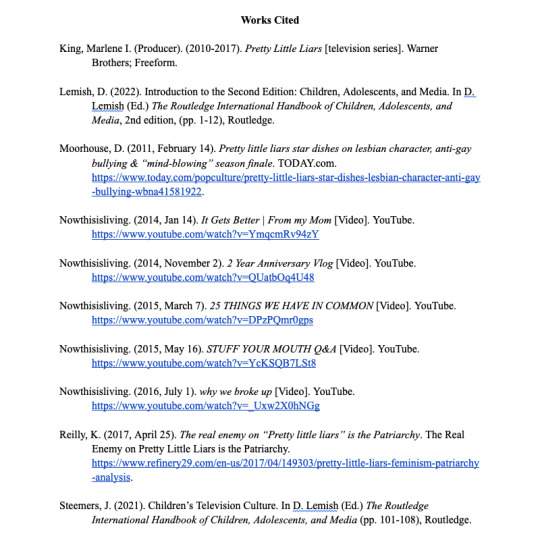
2 notes
·
View notes